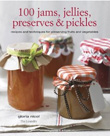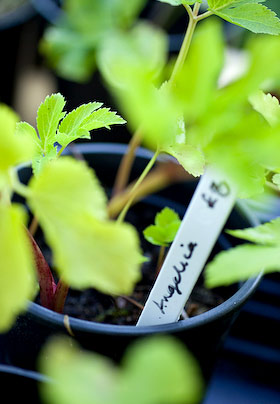
I first came across angelica, the herb, when I looked round my neighbours garden a few years ago. Jane and Les Hales’s garden is very special, so special in fact that it is open to the public a couple of days a year as part of the National Garden Scheme. Jane has planted angelica in several parts of the garden and uses this tall stately plant to form screens against the house. I was instantly impressed by the plants towering stature and amazing flowerheads that look so graphic and beautiful against blue sky.
Jane usually has a few seedlings for sale at her open days. Apparently once you manage to get angelica to grow, this biennial seeds itself freely, so restocking the plant is not an issue. I have tried growing it since then. The first two years, our wet summers encouraged the slugs to decimate my young plants, so even my best efforts came to nothing. This year is looking slightly brighter, and I already have a plant doing well on my allotment and a few more small seedlings that I am cherishing a little longer before planting them out to fend for themselves.
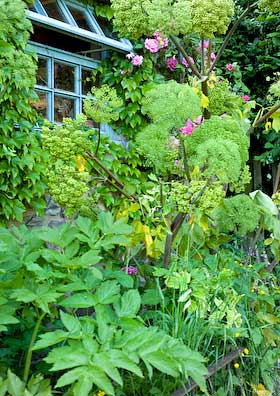
I had a vague recollection of candied angelica from my childhood, a strikingly vibrant green confectionery used to decorate trifles, a small strip pushed into the cream top layer either side of a bright red glace cherry, and can just about recall it having a rather exquisite and unusual flavour, but that was as far as my knowledge went. I certainly had no inkling that it came from a herbal or vegetable source. This of course set me off on a quest to find out more about the culinary merit of this impressive herb and I vowed to have a go at candying my own angelica to try and rediscover the distinctive flavour remembered as a kid.
All parts of the plant are aromatic and edible. The stems are the bits you candy to make confectionery, the leaves are used for flavouring many liqueurs such as chartreuse as well as in the preparation of bitters, and with juniper berries to flavour gin, the root is blended with wormwood and other herbs to make absinthe and the seeds impart a muscat-like flavour to wine and are used in the preparation of vermouth. All impressive stuff.
Stems for candying or crystallizing need to be young. It is no good waiting too long to harvest them as by June – July time they will be far too stringy and tough to work with. You will know by now that being prepared well enough ahead is not my strongest point, but this year, for once, no doubt prompted by Tigress’s can jam canning challenge I am taking part in, which has chosen herbs for our April ingredient, I have gotten round to acquiring a handful of stems and a nice bunch of leaves from Jane which she very kindly cut for me. The plan, to use angelica as my canjam ingredient (post to follow this one), but also to candy some stems at the same time.
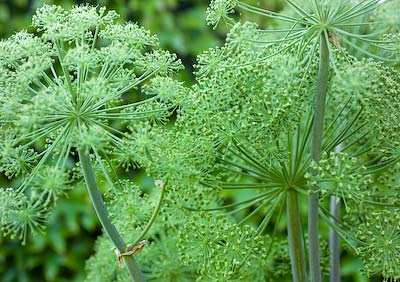
What is interesting is the point at which the angelica turns from a herby savoury scent and flavour to a sweet unctious syrupy one. The stems need first to be boiled and scraped, which is a bit fiddly, before layering them with sugar to begin the transformation. As I had very few stems to play with, I used some of the thicker leaf stalks as well. Apart from the peeling process, it was merely a matter of 5 or 10 minutes of activity followed by a day or so of leaving well alone, so it is hardly taxing. As soon as a syrup started to form, the angelica took on the magical taste I remembered and I felt as though I had captured the essence of this wonderous herb. It is worth having a go, even if you only candy angelica once in your life. The basic recipe I followed comes from Bee Nilson’s Herb Cookery, published in 1974. She is one of my favourite cookery writers for allsorts of reasons. Scale the recipe down if you don’t have enough stems.
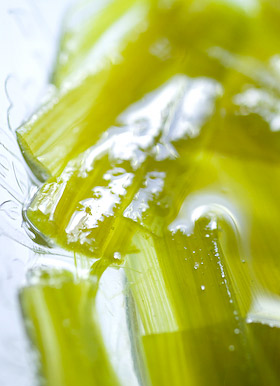
HOW TO CRYSTALLIZE ANGELICA
1/2kg (1lb) angelica stems
Wash the stems and cut into 8-15cm (3-6in) lengths. Boil them in enough water to cover until the stems are tender. For young stems this should only take about 10 minutes. Drain well, rinse with cold water and drain again. Scrape the outer skin from each piece. I found it easiest to slit down the side of each hollow tub and lay them flat on the surface. The skin comes off really easily but you need a lightness of touch so what remains isn’t damaged. Place them in a shallow dish.
1/2kg (1lb) caster sugar
Sprinkle the sugar evenly over the stems. Cover the dish and leave it for 2 days by which time the sugar will have dissolved and become syrupy.
250ml (1/2pt) water
Put the angelica, sugar syrup and water in a pan and heat whilst stirring until the syrup boils. Simmer gently until nearly all the syrup is absorbed and the angelica is clear. Add more water if the syrup has all gone but the stems aren’t looking transparent. Drain the angelica and leave till cool enough to handle, then roll them in more caster sugar to coat them generously. Spread the pieces on a wire cooling rack and finish drying them in a warm place or a very cool oven. When cold wrap the angelica in waxed paper to store.
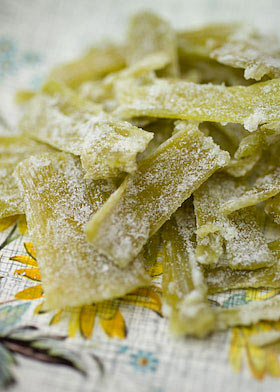
This year, Ramblers, Jane and Les Hale’s garden at Aylburton Common in the Forest of Dean, is open as part of the National Garden Scheme on two Sundays; 2nd May and 13th June 2-6 pm, and also by special appointment during May and June only. You can find more information on the National Garden Scheme website here.

What a lovely plant Angelica is and how useful if it can be decorative and serve as a screen as well as useful in the kitchen. I would love to try it here and then to have a go and candying some as the stuff you buy is often vividly coloured and not at all natural looking (not that I buy much or use it often you understand!)
Thanks for the info.
JAne
Comment by Jane 04.22.10 @ 6:41 pmI am wondering if angelica grows in the U.S. I’ve seen it dried, but not growing anywhere here in the northern U.S.
Comment by MK 04.22.10 @ 6:44 pmI love angelica, it’s such a beautiful plant. Have you ever tried cooking with sweet cicely? I always mean to and never get round to doing it…
Comment by Kim 04.22.10 @ 6:48 pmThere is a wonderful bronze form as well but I’m not sure if it would have the magical taste and smell of the green variety.As a child,I loved this so much I would use my pocket money to buy a packet instead of the usual sweets.
Comment by judy Dann 04.23.10 @ 8:56 amI live in Northern California. I believe Angelica
is a healing herb prized by the Pomo Tribes and grows wild in grazing land. At least I think so…!
Lovely feature – and I am jealous of the angelica – had some growing and must plant again. It grows in wild profusion on the Swedish islands outside Gothenburg.
Comment by Marie-Louise Avery 04.27.10 @ 4:47 pm[…] patch of rhubarb but noone in the house enjoys rhubarb enough to make use of it. As explained in my last post (just yesterday) Jane’s garden, a few doors down on the other side, has angelica growing so […]
Pingback by laundry etc 04.28.10 @ 9:58 pmWhat a lovely blog, and a wonderful article on Angelica. I was searching the web for growing tips on the plant which has just flowered this year in my english garden and I came across your recipe for crysrtallised angelica. It’s a brilliant architectural plant and it’s grown big and strong in a very short time (it’s even taller than me now)!
Comment by Julia 05.20.10 @ 10:06 pm

